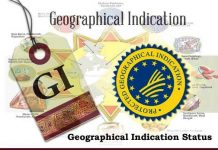This article is written by Nishka Kamath, a student at Nalanda Law College, University of Mumbai. It discusses all the major amendments and modifications carried on in the Geographical Indications of Goods (Registration and Protection) (Amendment) Rules, 2002.
Table of Contents
Introduction
There are a variety of goods that are either found naturally, cultivated agriculturally or are produced in a particular territory of a country, region or locality. These goods have particular characteristics either related to taste, aroma or quality and are marketed based on their place of origin or geographical indication. Geographical indications can be typically used for agricultural products, foodstuffs, wine and spirit drinks, handicrafts, and industrial products.
So, from having Darjeeling Tea or Kangra Tea after waking up to a smoothie made up of freshly chopped Alphonso Mangoes or a glass full of Nagpur Orange juice- post-workout, to dressing up in a Banarasi silk saree with Kolhapuri Chappal for a party and having biryani made up of Basmati Rice with a dash of flavoursome Alleppey Green Cardamom or Coorg Cardamom and Kashmir’s saffron, an individual comes across a wide variety of goods on a day to day basis, that has secured Geographical Indication (GI) rights.
As per the Government’s journal published on 21st September 2021, the recent Geographical Indications include:
- Kullu Shawl from Himachal Pradesh,
- Channapatna Toys and Dolls from Karnataka,
- Kashmir Pashmina from Srinagar, Jammu & Kashmir,
- Muga silk of Assam from Assam, inter alia.
The object of the Geographical Indication Act, 1999 is to provide for registration and better protection of geographical indications relating to goods. To further strengthen the Intellectual Property Ecosystem a Draft amendment related to the Geographical Indication of Goods (Registration and Protection) Rules, 2002 (hereinafter referred to as the ‘Draft Amendment Rules’) was released by the Ministry of Commerce and Industry, which is discussed below.
Brief history of the G.I. Act and Rules
When and why was the Geographical Indications Act introduced in India
We now know that GIs are indications used for goods that have a specific geographical origin and have characteristics or prestige due to their place of origin. Geographical indications are those precious rights that can be exploited by fraudulent commercial operators if they are not protected properly. This can cause harm to both, the consumer as well as the legitimate users.
Thus, in order to safeguard the interests of the consumers and users, the Trade-Related Aspects of Intellectual Property (TRIPS) Agreement was enacted. This agreement specifies minimum standards of protection of GIs with additional protection for wines and spirits. In congruence with the TRIPS Agreement, India took legislative action by enacting the Geographical Indications of Goods (Registration and Protection) Act, 1999, which became effective on 15th September 2003 and the Geographical Indications of Goods (Registration and Protection) Rules, 2002.
A note must be taken that, along with the TRIPS Agreement, there were 3 controversial cases related to Neem, Turmeric and Basmati rice which instigated the Indian government to implement a law for the prevention of unfair exploitation of GIs. There was a dire need for an extensive law for the registration and lawful protection to geographical indications and thus, the law was passed by the Parliament.
Why were the new Rules added to the G.I. Act
On 12th September 2019, the Ministry of Commerce and Industry by exercising its powers conferred under Section 87 of the Geographical Indications of Goods (Registration and Protection) Act, 1999 vide a Gazette Notification No. G.S.R. 645 (E), issued the draft rules on Geographical Indications of Goods (Registration and Protection) (Amendment) and also invited objections from the general public.
This amendment was carried on to further strengthen the Intellectual Property Ecosystem by deducting the GI registration process fees and easing the procedure for registration of an authorized user of the registered geographical indication.
Proposed Draft Amendment
As stated above, the new draft rules were issued and objections from the general public were invited. The objections were to be raised within 30 days from the date of notification, failure to which shall mean the public had no issues about the same. Also, only those objections which were brought up within the stipulated time were to be considered by the Central Government.
The proposed draft amendment had the following proposed amends:
- Only proposed authorized users can submit an application
The Draft Amendment Rules aim to make amends in Rule 56 (1) of the Geographical Indications of Goods (Registration and Protection) Rules, 2002. This rule deals with the application of the producer as an authorized user of a registered geographical location.
The application to the Registrar for registration in accordance with Section 17 by the producer as an authorized user was to be submitted in Form GI-3 together by the producer and the registered proprietor. Whereas, the new rule proposes that the joint application be removed by the registered proprietor, and that, only a copy of the application be forwarded to the registered proprietor and thus, to inform the Registrar of the same.
Thus, as per the new proposed draft amendment, only the proposed authorized user can submit an application to the Registrar. Whereas, the previous law stated that an application was to be filed jointly by the registered proprietor and the proposed authorised user.
Moreover, the statement of the case of how the proposed authorized user claims to be the producer of the registered geographical indication was previously needed to be filed along with an affidavit, but, as per the new Draft Amendment Rules, the statement of case can be filed without any affidavit.
- Requirement of Letter of Consent under Section 56 is recommended to be removed
According to the Draft Amendment Rules, the applicants must forward a copy of the application to the registered proprietor, and inform the Registrar of due service of the same. Also, the requirement for a copy of consent under 56 (2) has been eliminated.
- Rule 59 (1) was recommended to be modified
For the registration of an authorised user entry in the register, where an objection is filed and dismissed, the Registrar can enter the authorized user in Part B of the register and shall have a registration certificate issued with the seal of Geographical Indication Registry. As per the previous Act, the Registrar had to wait until the end of the appeal period after the objection was dismissed for entering the authorised user in Part B of the register and the same was to be done with a prescribed amount of fees. But with the Draft Amendment Rules, the appeal period and the fees charged were proposed to be removed.
In other words, the registration certificate in Form GI-3 was to be allocated by the Registrar only after the receipt of a request along with the prescribed fees was submitted. But now, the Draft Amendment Rules state that the references in Form GI-3, receipt of request and payment of the predefined fees stand withdrawn.
- Requirement of the Registrar to specify details
Earlier, the Registrar had to state and define all the particulars required under Section 6 (1) in the register of the authorized user.
However, with the Draft Amendment Rules, the need for the Registrar to specify the priority date and appropriate office of registry was eliminated. Thus, Clauses (f) and (g) of sub-rule (2) of Section 59 of the principal rules registry were excluded.
- Rule 59 (3) was recommended to be modified
Previously, any request for duplicates or copies of registration was to be made in Form GI-7 along with an unmounted representation of the geographical indication we portrayed in the application form for registration.
But now, after the Draft Amendment Rules, the supplement of un-mounted representation of the geographical indication as per the application form is discarded.
In other words, sub-rule (3) of Section 59 will be modified and unmounted representation of the geographical indication will not be needed when registration of goods is carried on.
- No fees to be charged for the registration of an authorized user of a registered GI
Earlier, in Schedule 1, under entry 3A, there was a prescribed fee of INR 500 (7 USD Approx.) which was to be paid for the registration of an authorized user of a registered geographical indication. With the new Draft Amendment Rules, this fee is removed, thus making the payment from INR 500 to nil. In the same manner, the fees for renewal under Entry 3C of the Schedule was reduced from INR 1000 (14 USD Approx.) to nil. Thus, there was a 100% reduction in the aforementioned fees.
- Request for issuance of certificate procedure omitted
Earlier, the request for a registration certificate was to be made in Form-GI-3. But with the Draft Amendment Rules, the procedure of requesting for issuance of the certificate is omitted.
- Entry in Schedule-II deleted
Under the Draft Amendment Rules, the entry in Schedule-II will be deleted and entry no. 3C will be substituted as entry no. 3B.
- Form GI-3 amended
Previously, the form consisted of three entries, that is:
- A for application,
- B for a request for the issuance of the certificate, and
- C for renewal.
With the new Draft Amendment Rules, the form consists of only two entries, they are:
- A for application, and
- B for renewal.
Since no objections and suggestions were issued from the public in respect to the said rules, the Central Government in the exercise of the powers conferred by Section 87 of the Geographical Indications of Goods (Registration and Protection) Act, 1999 amended the Act. It was further referred to as the Geographical Indications of Goods (Registration and Protection) Rules, 2002.

Some things one must know about the Geographical Indications of goods
- Registration of Geographical Indications
An application for the registration of a GI must be submitted to the Registrar of the geographical indications in the format specified under the Geographical Indications of Goods (Registration and Protection) Act, 1999 (the GI Act) read with the Geographical Indications (Registration and Protection) Rules, 2002 (the GI Rules).
- Duration of Protection
A geographical indication is registered for a time span of 10 years and the renewal of the registration can be done from time to time for a period of 10 years on a stretch.
- Protection of Geographical Indications
There are four methods in which geographical indications can be protected:
- the so-called sui generis system (i.e. special regimes of protection),
- by using collective or certification marks,
- through procedures that focus on business practices, including administrative product approval schemes, and
- through unfair competition laws.
A note must be taken that these methods have been advanced in accordance with several distinct legal traditions and within a framework of an individual’s historical and economic conditions.
- Prohibition of Registration of certain geographical indications
Certain goods prohibit the registration of certain geographical indications, some of them are:
- the usage of which is likely to be misleading or that which can cause complication, or
- the usage of which would contradict any law for the time being in force, or
- which incorporates disreputable or improper matter, etc.
- Infringement of Geographical Indications
Under the Geographical Indication of Goods (Registration and Protection) Act, 1999, forgery of a geographical indication will attract a penalty which is punishable by imprisonment for a term which may not be less than six months but may be extended to three years and a fine not less than INR 50,000 (approx. USD 800), but may extend to INR 2,00,000 (approx. USD 3,000).
Current update
On 26th August 2020, the Ministry of Commerce and Industry (Department for Promotion of Industry and Internal Trade) vide notification G.S.R. 528(E) have made amends in the Geographical Indications of Goods (Registration and Protection) Rules, 2002. These rules will now be called the Geographical Indications of Goods (Registration and Protection) (Amendment) Rules, 2020 (hereinafter referred to as ‘GI Rules 2020’). Changes have been carried out in Section 56 and Section 59, inter alia.
Conclusion
The laws on the geographical indication of goods are not very old in India. With the rapid growth in technology and globalisation, there is a requirement for additional protection of traditional knowledge of various localized communities. Particularly, when foreign companies are attempting to abuse conventional ancestral knowledge without proper approval, it is high time to make the protection under geographical indications available to all, that too, on a large scale.
Thus, bringing amends to these rules is a positive step forward. The simplification of procedures for registration of GIs and authorized users as well as a significant reduction in registration and renewal fees will go a long way in helping the communities to safeguard their products under these laws.
References
- https://www.mondaq.com/india/trademark/655394/geographical-indications-law-in-india-everything-you-must-know?login=true
- https://www.google.com/amp/s/www.novojuris.com/thought-leadership/draft-amendment-to-geographical-indications-of-goods-registration-and-protection-rules-2002.amp
- https://www.novojuris.com/thought-leadership/draft-amendment-to-geographical-indications-of-goods-registration-and-protection-rules-2002
- https://www.mondaq.com/india/trademark/852270/draft-amendment-to-the-geographical-indications-of-goods-registration-protection-rules-2002
- https://dpiit.gov.in/sites/default/files/GI_DraftRules_16September2019.pdf
- https://www.wipo.int/geo_indications/en/?gclid=CjwKCAiA1aiMBhAUEiwACw25MbFaUxElvblUdr9xhJy59KineBB2x8RXiNypJsbLVla_3D4ktSrLghoCiLkQAvD_BwE
- https://www.lexology.com/library/detail.aspx?g=252e1fd7-f1b7-437f-80a5-fab8434e74cb
LawSikho has created a telegram group for exchanging legal knowledge, referrals and various opportunities. You can click on this link and join:
https://t.me/joinchat/L9vr7LmS9pJjYTQ9
Follow us on Instagram and subscribe to our YouTube channel for more amazing legal content.










